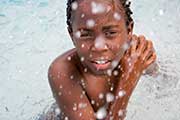
THURSDAY, May 15, 2014 (HealthDay News) — Black children are more than five times as likely to drown in swimming pools as their white peers, U.S. health officials reported Thursday.
“There are striking disparities,” said lead researcher Dr. Julie Gilchrist, a medical epidemiologist in the division of unintentional injury prevention at the U.S. Centers for Disease Control and Prevention.
Gilchrist thinks these disparities result from many minorities not having been taught basic swimming skills. “A teenager who drowns in a backyard swimming pool that is only 6- or 7-feet deep — that’s just lack of basic swimming skill,” she said.
“There is evidence that suggests that African Americans lack basic swimming skills at greater numbers than their white or Hispanic counterparts,” Gilchrist added.
Access to swimming pools is one problem. “But it’s also a cultural choice as to how you spend your recreational time and dollars. I think parents perceive swimming as just another recreational activity, and they may choose soccer or baseball or basketball instead,” she said.
Many parents don’t see swimming as a necessary lifesaving skill, Gilchrist said. “Actually, learning basic swim skills, such as being able to right yourself in the water, control your breathing, float and swim 25 yards is lifesaving,” she noted.
Gilchrist doesn’t think learning swimming strokes is as important as learning survival skills. “As far as reducing these disparities, swim skills would go a long way,” she suggested.
Drowning is a leading cause of injury-related death in children, according to the American Academy of Pediatrics (AAP). In 2006, about 1,100 U.S. children younger than 20 died from drowning.
According to the AAP, one study found that swimming lessons can reduce the risk of drowning by 88 percent.
Parents can find basic swimming programs at local YMCAs and through the Red Cross, Gilchrist said. The CDC and the AAP support giving kids swim lessons. These lessons can start as early as the age of 1, Gilchrist said.
“Swimming is a lifesaving skill — it’s a necessity, it’s not a recreation,” Gilchrist noted.
In addition to swim skills, she said, lifeguards, life jackets, fences and bystander CPR are all important in preventing drowning.
The report was published May 16 in the CDC’s Morbidity and Mortality Weekly Report.
According to the report, the risk of drowning among minorities, including American Indians/Alaska Natives and blacks up to age 29, is far greater than among whites.
An analysis of 12 years of data showed that the drowning rate for American Indians/Alaska Natives is twice the rate for whites, and the drowning rate for blacks is 1.4 times the rate for whites.
The greatest disparity is in swimming pool drowning, with black children aged 5 to 19 facing a 5.5 times higher rate than white children, the study found.
The Red Cross recommends:
- Swim in areas supervised by lifeguards.
- Swim with a buddy.
- Make sure everyone in the family learns to swim well.
- Enroll in Red Cross water orientation and learn-to-swim courses.
- Never leave a child near water unattended.
- Do not trust a child’s life to another child.
- Teach children to always ask permission to go near water.
- Young children or inexperienced swimmers should wear U.S. Coast Guard-approved life jackets.
More information
For more on drowning, visit the U.S. National Library of Medicine.
Copyright © 2025 HealthDay. All rights reserved.

